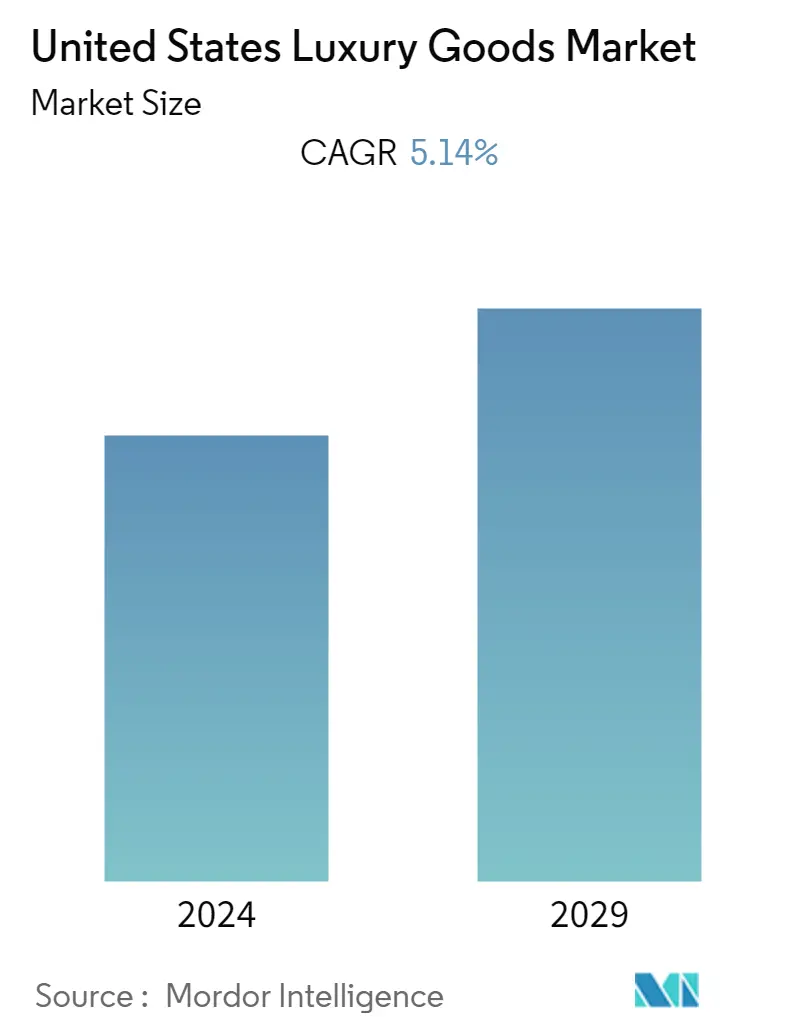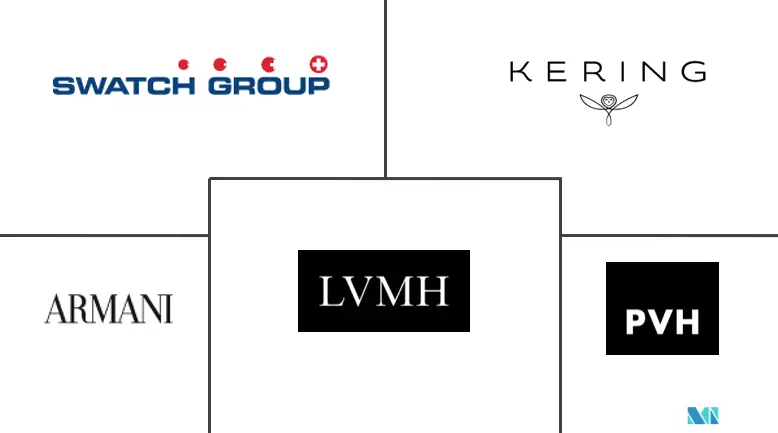Market Size of United States Luxury Goods Industry

| Study Period | 2019 - 2029 |
| Base Year For Estimation | 2023 |
| Forecast Data Period | 2024 - 2029 |
| Historical Data Period | 2019 - 2022 |
| CAGR | 5.14 % |
| Market Concentration | Low |
Major Players
*Disclaimer: Major Players sorted in no particular order |
USA Luxury Goods Market Analysis
The United States luxury goods market is projected to grow at a CAGR of 5.14 % during the forecast period (2022 - 2027).
The demand for luxury goods in the United States is attributed to the widespread wealthy population with high income, willing to spend on high-end personal luxury accessories marketed by luxury brands. Further, the country has a well-established network of single-brand and multi-brand shops in airports, and shopping malls which allow affluent consumers to choose from diversified product offerings of regional and global luxury brands. Further, as more individuals prefer using premium and curated collections of apparel, and jewelry, curated fashion stores are increasingly expanding in the country to serve the evolving fashion needs of U.S. consumers.
In the medium term, the sales of luxury goods are anticipated to register substantial growth as key brands are directing their investment in digital marketing and partnering with e-commerce platforms to cater to the increasing number of online shoppers. Additionally, luxury fashion companies are tightening their brand values by not compromising on the quality of the products and instead, offering limited-time offers, deals, and discounts only on the purchase of a specific amount of clothing, fashion accessories, or beauty products on brand websites. This organic consumer engagement is anticipated to drive market growth during the forecast period.
USA Luxury Goods Industry Segmentation
Luxury goods refer to premium or elite quality products which are expensive as compared to conventional goods. The United States luxury goods market is segmented by type and distribution channel. By type, the market is segmented into clothing and apparel, footwear, bags, jewelry, watches, and other types. By distribution channel, the market is segmented into single-brand stores, multi-brand stores, online stores, and other distribution channels. The report offers market size and values in (USD Million) during the forecasted years for the above segments.
| By Type | |
| Clothing and Apparel | |
| Footwear | |
| Bags | |
| Jewelry | |
| Watches | |
| Other Accessories |
| By Distribution Channel | |
| Single-brand Stores | |
| Multi-brand Stores | |
| Online Stores | |
| Other Distribution Channels |
United States Luxury Goods Market Size Summary
The United States luxury goods market is experiencing a robust expansion, driven by a wealthy consumer base with a penchant for high-end personal luxury accessories. The country's extensive network of single-brand and multi-brand outlets, particularly in airports and shopping malls, offers affluent consumers a diverse range of products from both regional and global luxury brands. The growing preference for premium and curated fashion collections has led to the expansion of curated fashion stores, catering to the evolving tastes of U.S. consumers. In the medium term, the market is expected to witness significant growth as luxury brands invest in digital marketing and e-commerce partnerships to reach the increasing number of online shoppers. This strategic focus on maintaining brand value through quality and limited-time offers is anticipated to further propel market growth.
The U.S. luxury goods market is characterized by a fashion-conscious consumer base with high purchasing power, influenced by social media and celebrity endorsements. The demand for unique designs and the durability of luxury products sets them apart from fast fashion, appealing particularly to millennials. The apparel and clothing segment has seen rapid growth, with luxury brands offering trendy, street-style ready-to-wear and customized clothing to attract younger consumers. The rise of luxury athleisure, driven by the wellness economy, has also contributed to market expansion. Post-COVID, there has been an increase in sales of luxury gym and yoga wear as consumers focus on health and wellness. The market is highly competitive, with major players like Giorgio Armani, Rolex, and Kering Group engaging in mergers, acquisitions, and strategic collaborations to maintain their market share.
United States Luxury Goods Market Size - Table of Contents
-
1. MARKET DYNAMICS
-
1.1 Market Drivers
-
1.2 Market Restraints
-
1.3 Porter's Five Force Analysis
-
1.3.1 Threat of New Entrants
-
1.3.2 Bargaining Power of Buyers/Consumers
-
1.3.3 Bargaining Power of Suppliers
-
1.3.4 Threat of Substitute Products
-
1.3.5 Intensity of Competitive Rivalry
-
-
-
2. MARKET SEGMENTATION
-
2.1 By Type
-
2.1.1 Clothing and Apparel
-
2.1.2 Footwear
-
2.1.3 Bags
-
2.1.4 Jewelry
-
2.1.5 Watches
-
2.1.6 Other Accessories
-
-
2.2 By Distribution Channel
-
2.2.1 Single-brand Stores
-
2.2.2 Multi-brand Stores
-
2.2.3 Online Stores
-
2.2.4 Other Distribution Channels
-
-
United States Luxury Goods Market Size FAQs
What is the current United States Luxury Goods Market size?
The United States Luxury Goods Market is projected to register a CAGR of 5.14% during the forecast period (2024-2029)
Who are the key players in United States Luxury Goods Market?
Giorgio Armani S.p.A., Kering, PVH Corp., LVMH Moët Hennessy Louis Vuitton and The Swatch Group Ltd are the major companies operating in the United States Luxury Goods Market.

